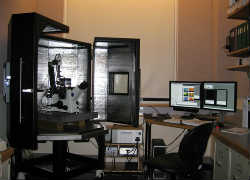Asylum Atomic Force Microscope

MFP-3D-BIOTM
Atomic Force Microscope by
Asylum Research is mounted on Olympus IX71 inverted microscope that resides on a Herzan AVI 350-S Active Vibration
Isolation Table which dynamically dampens the most extreme vibrational disturbances; and the system is totally enclosed in an air tight state-of-the-art BCH-45 Large Acoustic Isolation Hood with air temperature control capabilities. The closed looped
system allows investigation of dry or hydrated biological/materials surface features at very high resolution to include dynamic 3D visual analysis, force curves, optical (fluorescence and phase) image overlays precisely registered over AFM topographical
information; plus advanced modes such as nanomanipulation(s), nanoindentation(s), Dual AC and more. The system software modules are written in Igor Pro, an integrated program by Wavemetrics which provides very advanced features for visualizing, analyzing,
transforming and presenting experimental data.
Cypher Atomic Force Microscope

The Asylum Research Cypher ES
boasts exceptional performance and full environmental control features.
It masters high resolution imaging with speed and stability while
containing an easily operatable environmental chamber to control gas or
liquid environments, at temperatures from 0-250°C, and in some of the
harshest chemical environments. The Cypher ES is the ultimate AFM for
the most demanding experimental requirements.
- Routinely achieve higher resolution than other AFMs
- Fast scanning with results in seconds instead of minutes
- Every step of operation is simpler for remarkable productivity
- Small footprint in the lab, huge potential to grow in capability
- Support that goes above and beyond your expectations
- Enables gas and liquid perfusion through a sealed cell
- Controls sample temperature over a wide 0–250°C range
- Broadest compatibility with harsh chemicals